How To Install A Wall Hung Sink
Installing a Bathroom Sink: Wall-Hung Sink
Replace your old vanity with a contemporary wall-hung sink.
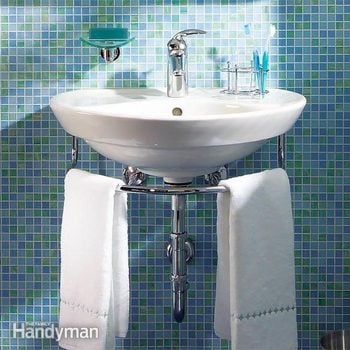 Family Handyman
Family Handyman
Replacing a vanity with a wall-hung sink is one of the best ways to make a small bathroom feel roomier. As the floor space opens up, the room becomes brighter and easier to clean. In this story, we'll show you how to install a stylish wall-hung bathroom sink and faucet, including the tough part: moving the water supply and drainpipes. We'll also show you how to open the wall, cut the pipes and reroute them for easy hook-up.
You might also like: TBD
- Time
- Complexity
- Cost
- Multiple Days
- Intermediate
- $101–250
Wall mount bathroom sink project planning and preparation

The bathroom before the remodel
The original fixtures were starting to reveal their age.

The bathroom after the remodel
The new of the wall mount bathroom sink look is fresh, open and the bathroom is easy to clean.
Replacing a vanity with a wall-hung sink does more than bring a fresh, welcome look to your old bathroom. It's also one of the best ways to make a small bathroom feel roomier.
As the floor space opens up, the room becomes brighter and easier to clean. And it's the perfect time to update the lights, mirror and perhaps the medicine cabinet as well. The tradeoff, of course, is a loss of storage space. So as part of a bath remodel, consider adding a larger medicine cabinet/mirror, a small freestanding cabinet or even cabinetry or shelving above the toilet to handle the stuff you used to store in the vanity.
In this story, we'll show you how to install the new wall-hung sink and faucet. Installation is easier than it sounds. We'll show you the step-by-step techniques to do the whole job in a weekend, or two weekends if you decide to tile behind the sink as we did. However, as in any plumbing project, complications often come up.
Before attempting this project, you should have some experience soldering copper, assembling P-traps and installing shutoff valves. If you're inexperienced, allow extra time to work through these steps. Consider, too, that you may have to install new flooring if the old flooring was cut around the vanity. Finally, note that nearly every tip and technique we mention in this story is applicable to pedestal sinks as well as to wall-hung units.
You'll need to pick up a plumbing permit from the building department for this project. While you're there, find out when inspections are called for and whether a pressure test on the drains will be required.
The easiest way to find a good selection of wall-hung lavatories is to type "wall-hung lavatories" into any search engine or by browsing manufacturers' Web sites. Every manufacturer has a dealer finder to help you find the supplier closest to you. Another option is to go to a home center and ask to leaf through manufacturers' catalogs. It's unlikely you'll find anything but utilitarian, no-frills sinks in stock, so you'll probably have to special-order more stylish types of sinks. Most manufacturers give specifications and mounting information, so you can make sure the one you like will fit into the spot you plan for it. Each company will have at least a few color and faucet style options for each sink model it carries.
When you order the sink, you'll need to specify the faucet hole arrangement. Choices will include one hole for a single lever, or 4- or 8-in. centered holes for separate hot and cold valves. It's wise to decide on a faucet style first, then pick and order your sink with the faucet holes that suit the faucet you select. The sink we feature here is a Ravenna Semi-Pedestal Sink made by American Standard.
Whatever unit you choose, order the sink and faucet well ahead of time so you can get your bathroom back on-line as quickly as possible. What you'll need It's impossible to predict every plumbing part you'll need until you open up the wall (Photo 3). If you have to move copper water lines, you'll need the typical copper-working tools like a pipe cutter, fitting cleaners, a torch, flux and solder. If you have other types of supply pipes (rigid or flexible plastic), pick up a set of manufacturer's instructions or buy a how-to book about the material at a home center or bookstore to learn how to work with it.
If you have to move drain lines, you'll need a hacksaw along with the correct cleaner and cement for the plastic you choose. Other than those specialty items, you'll only need standard carpentry tools and a screw gun, wrenches and slip-joint pliers (Photo 11).
Remove the vanity and size up the plumbing

Photo 1: Remove the vanity top
Shut off the main water supply valve and disconnect the water and drain lines. Slit any caulk between the backsplash and wall, then pry the top free of the vanity.
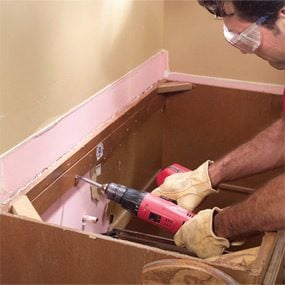
Photo 2: Remove the vanity
Back out the screws that secure the vanity base to the wall, pull it free and carry it away.
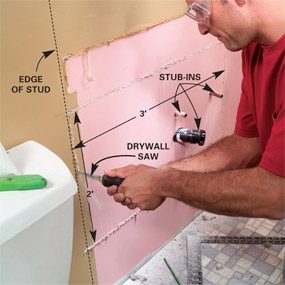
Photo 3: Remove the drywall
Locate nearby studs and cut along the studs, removing a 2 x 3-ft. section of the drywall surrounding the plumbing stub-ins.
Since the supply valves and drain will be exposed under your new sink, it's likely that you'll have to shift some existing plumbing inside the wall to make the wall penetrations look professional (straight, aligned, centered under the sink and at an acceptable height).
As a rule, plumbers aren't too careful when the plumbing is concealed within a vanity. In our case, the water lines were crooked, too close together and too low. Figure out which plumbing needs reworking by shutting off the water, disconnecting the plumbing, and removing the vanity and sink to expose the wall penetrations (Photos 1–4).
Then reinstall the valves or solder caps on the ends of the water lines to get the water back on to the house. With a clear view of the wall and plumbing, draw a center line through the middle of the waste line and mark the sink rim height on the wall. Use your sink's instructions to determine the ideal position for the pipes. Then decide which pipes, if any, need to be moved. For the best appearance, we recommend that you center the drain on the sink and shift the supply tubes fairly close to the sink.
If any plumbing lines need to be moved, mark and cut about a 2 x 3-ft. access hole in the drywall around the plumbing. That should give you enough space to do the work. Don't worry about removing too much; patching a large hole isn't much more work than fixing a small one. Cut the vertical sides of the holes flush with the sides of studs (Photo 3). After the plumbing rework, nail or screw backing boards to those studs to anchor the new drywall patch to them (Photo 7). If you don't have to move the plumbing, just cut a hole large enough to install blocking for anchoring the sink.
With the wall open, you can size up your situation. Supply pipes are easy to shift, but drains can be difficult. If the drain runs vertically in the wall, you can usually shift it fairly easily. But if it runs horizontally, as ours does (Photo 4), you can easily shift it left or right, but up and down is difficult. Call in a plumber to help, or compromise with a less-than-ideal position. We compromised, leaving ours slightly lower, and added a longer tailpiece (Photo 17). If you have to switch from one type of drainpipe to another (ABS, PVC or steel), use a transition coupling (Photo 6).
Buy the parts before you cut any pipes. It's important to write up a shopping list of plumbing parts and tools before cutting out live plumbing. Otherwise your house could be without water for a long time. Start by checking the pipe sizes (diameters will be stamped on the sides) and make a shopping list of the fittings and tubing lengths you'll need for the new positions. Include new chrome supply valves, supply lines (with fittings that will fit your new faucet), drain parts and escutcheons (an extra deep "box flange" for the drain). Study Photos 10–18 to learn the names of the parts we used and to see how they look.
CAUTION!
If you spot any electrical outlets on either side of the wall, cut a small inspection hole to check for electrical cable before cutting open the wall (Photo 3).
Reroute the water lines
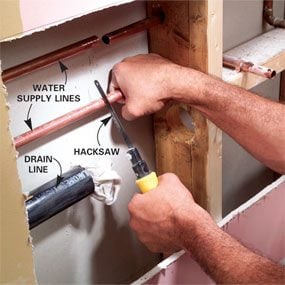
Photo 4: Cut the water and drain lines
Cut off the water supply and drain lines at least 1 ft. away from the old locations to leave enough space for rerouting the lines.

Photo 5: Mark the sink location
Mark the sink center and solder on the new copper parts to center the new water supply lines. Space them 8 in. apart and 21 to 23 in. above the floor.
Shut off the house's main water supply valve and cut off the water lines far enough back so you'll have plenty of room for the fittings and lengths you'll need to reposition them (Photo 4).
Your sink may call for specific locations, but if not, plan on centering them under the sink, spacing them 8 in. apart and between 21 and 23 in. above the floor. Anchor support bracket(s) at the height you choose, then cut the tubing lengths with a tubing cutter and dry-fit all the parts together to make sure of the final locations.
You can buy support brackets or make your own by cutting tubing lengths 1 in. longer than the stud space and flattening the ends with a hammer. Then hold the strap diagonally while tapping one corner into the stud at the right height. Drive the other end down until the tube is level; the sharp ends will dig into the wood.
Be sure to leave at least 3 in. of supply tubing sticking past the finished wall to leave room for cutting off the tubes later. Solder caps on the ends. Then take everything apart, clean and flux the fittings and tubing ends, and reassemble the parts. Solder each joint and the tubing to the support bracket at the resting point. The last step here is to turn on the water and check for leaks.
Reroute waste lines
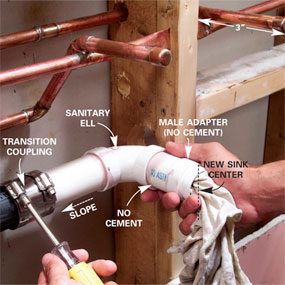
Photo 6: Install the new waste pipes
Cut and cement the drain line parts to fit the new center position. Join them to the existing drain line with a transition coupling. Maintain a slight slope.
The easiest way to cut off waste lines is with a reciprocating saw, but any type of handsaw will work too. Use a hacksaw for steel. Cut off the pipe so there'll be at least enough room for the length of the transition coupling and elbow (Photo 6).Use a special "sanitary" elbow in the wall rather than a regular 90-degree elbow.
Clean the parts and cement them together, but don't cement the nipple or the male adapter yet. Drain lines must have a 1/8- to 1/4-in. slope. Stuff a rag into the male adapter to keep sewer gas out of the house.
Add blocking and close up the wall
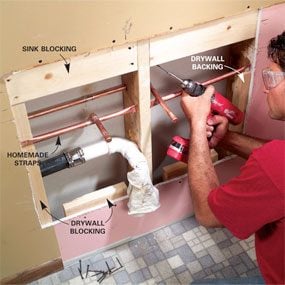
Photo 7: Add support blocks
Mark the sink height, then toe-screw 2×6 backers to the studs to support the sink bolts, cutting out more drywall as necessary. Add more backers as necessary to support the new drywall.
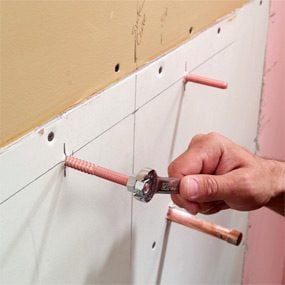
Photo 8: Attach the mounting bolts
Patch the hole with drywall, then mark the positions for the sink mounting bolts. Drill pilot holes and screw the bolts into the blocking using both mounting nuts tightened against each other.

Photo 9: Tile and paint
Tape and sand the drywall seams. Then prime and paint or tile the wall as desired. We added a 4-ft. wide column of tile from floor to ceiling.
Follow the sink directions to determine the height of the blocking that supports the sink (Photo 7).You may have to cut out more drywall above the original opening to get the blocking at the right height. Slip the top of the blocking behind the existing drywall and then toe-screw the bottom and the faces of the blocking to the studs with three 3-in. screws at each end. Add more blocking and install the new drywall patch.
Mount the sink

Photo 10: Install the shut-off valves
Cut the water supply lines 1 in. beyond the finished wall. Slip escutcheons over the lines and snug up but don't fully tighten the compression fitting valves.

Photo 11: Mount the faucet and drain first
Trim back the faucet supply lines to about 7 and 8 in. Then install the faucet and sink tailpiece following the manufacturer's instructions.
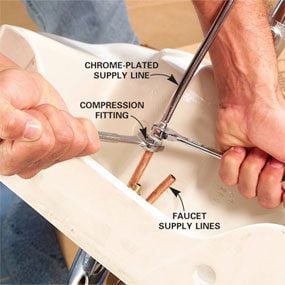
Photo 12: Install supply tubes
Smear pipe dope onto the threads of the supply line compression fittings and tighten them onto the faucet supply lines.

Photo 13: Mount the sink to the wall
Slip the sink over the mounting bolts and finger-tighten the mounting nuts over the washers. Lift the sink slightly while tightening the nuts with a wrench.
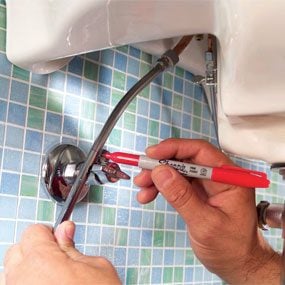
Photo 14: Mark and cut the supply tubes
Bend the supply lines gently to meet the supply valves at a right angle. Mark and cut the tubing even with the bottom of the threads on the valves.
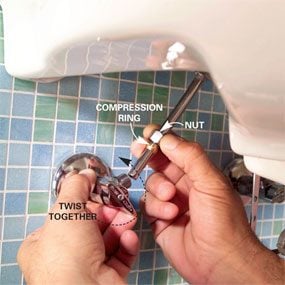
Photo 15: Connect the water lines
Rotate the valve nuts slightly, slip the compression rings and nuts on and twist the line and valve together. Tighten the valve and water line compression nuts.

Photo 16: Connect the waste line
Pull the nipple free of the elbow and cut a new piece so that only the male adapter threads project past the wall. Cement the nipple into the adapter and the elbow.
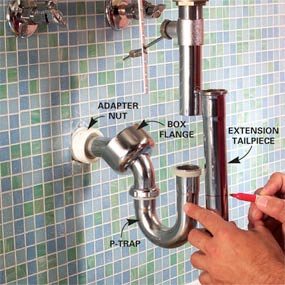
Photo 17: Connect the trap
Slip a box flange (which is extra deep) onto the P-trap and push the P-trap into the adapter. Hold the extension tailpiece in place, mark it even with the bottom of the belled part of the P-trap and cut it to length.
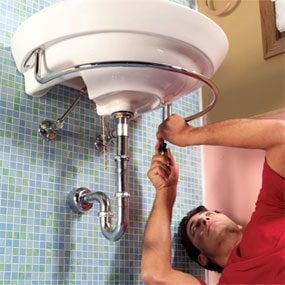
Photo 18: Tighten and check for leaks
Align all of the drain assembly parts and tighten the nuts. Then install sink accessories.
Mount the faucet and tailpiece before hanging the sink because it's tough getting access after it's attached to the wall. If your faucet has unfinished brass supply lines, cut them off shorter with a tubing cutter before mounting the faucet (Photo 11). Splice on finished chrome water lines after mounting the faucet (Photo 12).
Hang the sink on the anchors and snug up the nuts, but be careful not to over-tighten or you may crack the porcelain. The key is to support the sink while you tighten. When there's no wiggle left between the sink and the wall, you're done.
Turn off the water again. Cut the copper lines off 1 in. past the wall and slip on compression fitting valves with the water feeds facing up, but don't fully tighten the nuts yet. Mark the supply tube lengths by holding them alongside the valves (Photo 14).
Cut the supply tubes with a tubing cutter. It's a bit tricky to fit the tubes into the valves because the tubes don't easily flex. Slide the nut and brass ferrule onto the tube, then rotate the valve to help catch the tube end. To be leak-proof, the tube must seat at a right angle to the valve. Tighten the nut to anchor the tube and finish tightening the nut on the valve.
Pull the drain nipple free of the wall and cut a new one so just the threads of the male adapter project past the wall (Photo 16). Glue it and the male adapter in place. Push the P-trap into the male adapter until it aligns with the tailpiece. If the horizontal part is too long, you'll have to cut it shorter with a hacksaw. If the drain is too low, install an extension tailpiece, as we show in Photo 17.
Assemble the parts loosely until everything aligns, then snug up the nuts by hand and tighten an extra quarter turn with a pipe wrench or slip-joint pliers. Now turn on the water and check for leaks.
Connections for Galvanized and Plastic Pipes
Older homes may have galvanized steel or copper waste lines and galvanized water lines. Don't let them intimidate you. If you need to reroute galvanized drain lines, you have two options. One is to open enough wall to reach the first threaded fitting, unscrew the pipe, and screw in a matching threaded PVC or ABS plastic male adapter and convert the line to plastic parts. Or, if the first threaded fitting is beyond your reach or impossible to loosen, cut off the pipe with a hacksaw or reciprocating saw and convert to plastic with a transition coupling. Base the decision on which is easier. If you have copper waste lines, there are also special transition couplings available for converting them to plastic, but you'll have to go to a specialty plumbing supply store to find them.
With galvanized water lines, you have to get back to the first joint, unscrew it, and convert the pipe to CPVC fittings and pipes. Most home centers and hardware stores stock CPVC fittings and tubing.
Required Tools for this Project
Have the necessary tools for this DIY project lined up before you start—you'll save time and frustration.
You'll also need pipe fitting cleaners. If you're going to tile around the sink, you'll need tile installation tools.
Required Materials for this Project
Avoid last-minute shopping trips by having all your materials ready ahead of time. Here's a list.
If you're adding tile, you'll also need tile, adhesive and grout.
Similar Projects
How To Install A Wall Hung Sink
Source: https://www.familyhandyman.com/project/installing-a-bathroom-sink-wall-hung-sink/
Posted by: ullrichdarpre.blogspot.com

0 Response to "How To Install A Wall Hung Sink"
Post a Comment